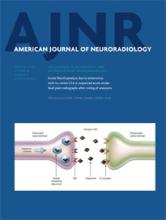Research ArticleBrain
Do FLAIR Vascular Hyperintensities beyond the DWI Lesion Represent the Ischemic Penumbra?
L. Legrand, M. Tisserand, G. Turc, O. Naggara, M. Edjlali, C. Mellerio, J.-L. Mas, J.-F. Méder, J.-C. Baron and C. Oppenheim
American Journal of Neuroradiology February 2015, 36 (2) 269-274; DOI: https://doi.org/10.3174/ajnr.A4088
L. Legrand
aFrom the Departments of Radiology (L.L., M.T., O.N., M.E., C.M., J.-F.M., C.O.)
M. Tisserand
aFrom the Departments of Radiology (L.L., M.T., O.N., M.E., C.M., J.-F.M., C.O.)
G. Turc
bNeurology (G.T., J.-L.M, J.-C.B.), Université Paris Descartes Sorbonne Paris Cité, Centre de Psychiatrie et Neurosciences, Institut National de la Santé et de la Recherche Médicale S894, Centre Hospitalier Sainte-Anne, Paris, France.
O. Naggara
aFrom the Departments of Radiology (L.L., M.T., O.N., M.E., C.M., J.-F.M., C.O.)
M. Edjlali
aFrom the Departments of Radiology (L.L., M.T., O.N., M.E., C.M., J.-F.M., C.O.)
C. Mellerio
aFrom the Departments of Radiology (L.L., M.T., O.N., M.E., C.M., J.-F.M., C.O.)
J.-L. Mas
bNeurology (G.T., J.-L.M, J.-C.B.), Université Paris Descartes Sorbonne Paris Cité, Centre de Psychiatrie et Neurosciences, Institut National de la Santé et de la Recherche Médicale S894, Centre Hospitalier Sainte-Anne, Paris, France.
J.-F. Méder
aFrom the Departments of Radiology (L.L., M.T., O.N., M.E., C.M., J.-F.M., C.O.)
J.-C. Baron
bNeurology (G.T., J.-L.M, J.-C.B.), Université Paris Descartes Sorbonne Paris Cité, Centre de Psychiatrie et Neurosciences, Institut National de la Santé et de la Recherche Médicale S894, Centre Hospitalier Sainte-Anne, Paris, France.
C. Oppenheim
aFrom the Departments of Radiology (L.L., M.T., O.N., M.E., C.M., J.-F.M., C.O.)

REFERENCES
- 1.↵
- Azizyan A,
- Sanossian N,
- Mogensen MA, et al
- 2.↵
- Sanossian N,
- Saver JL,
- Alger JR, et al
- 3.↵
- Lee KY,
- Latour LL,
- Luby M, et al
- 4.↵
- 5.↵
- 6.↵
- 7.↵
- 8.↵
- Ebinger M,
- Kufner A,
- Galinovic I, et al
- 9.↵
- Cheng B,
- Ebinger M,
- Kufner A, et al
- 10.↵
- 11.↵
- Schellinger PD,
- Chalela JA,
- Kang DW, et al
- 12.↵
- Kamran S,
- Bates V,
- Bakshi R, et al
- 13.↵
- 14.↵
- Toyoda K,
- Ida M,
- Fukuda K
- 15.↵
- Cosnard G,
- Duprez T,
- Grandin C, et al
- 16.↵
- Bang OY,
- Saver JL,
- Kim SJ, et al
- 17.↵
- 18.↵
- Labeyrie MA,
- Turc G,
- Hess A, et al
- 19.↵
- Lansberg MG,
- Straka M,
- Kemp S, et al
- 20.↵
- 21.↵
- 22.↵
- 23.↵
- Muir KW,
- Buchan A,
- von Kummer R, et al
- 24.↵
- Donnan GA,
- Baron JC,
- Ma H, et al
In this issue
American Journal of Neuroradiology
Vol. 36, Issue 2
1 Feb 2015
Advertisement
L. Legrand, M. Tisserand, G. Turc, O. Naggara, M. Edjlali, C. Mellerio, J.-L. Mas, J.-F. Méder, J.-C. Baron, C. Oppenheim
Do FLAIR Vascular Hyperintensities beyond the DWI Lesion Represent the Ischemic Penumbra?
American Journal of Neuroradiology Feb 2015, 36 (2) 269-274; DOI: 10.3174/ajnr.A4088
0 Responses
Jump to section
Related Articles
- No related articles found.
Cited By...
- FLAIR Vascular Hyperintensities as a Surrogate of Collaterals in Acute Stroke: DWI Matters
- Postprocedural Antiplatelet Treatment after Emergent Carotid Stenting in Tandem Lesions Stroke: Impact on Stent Patency beyond Day 1
- Clot Burden Score and Collateral Status and Their Impact on Functional Outcome in Acute Ischemic Stroke
- Clinical prognosis of FLAIR hyperintense arteries in ischaemic stroke patients: a systematic review and meta-analysis
- Assessment of a Bayesian Vitrea CT Perfusion Analysis to Predict Final Infarct and Penumbra Volumes in Patients with Acute Ischemic Stroke: A Comparison with RAPID
- The Association between FLAIR Vascular Hyperintensity and Stroke Outcome Varies with Time from Onset
- Predictors and Clinical Impact of Delayed Stent Thrombosis after Thrombectomy for Acute Stroke with Tandem Lesions
- FLAIR vascular hyperintensities predict early ischemic recurrence in TIA
- Do Fluid-Attenuated Inversion Recovery Vascular Hyperintensities Represent Good Collaterals before Reperfusion Therapy?
- Fluid-Attenuated Inversion Recovery Vascular Hyperintensity Topography, Novel Imaging Marker for Revascularization in Middle Cerebral Artery Occlusion
- Fluid-Attenuated Inversion Recovery Vascular Hyperintensities-Diffusion-Weighted Imaging Mismatch Identifies Acute Stroke Patients Most Likely to Benefit From Recanalization
- MRI of Acute Stroke: What Went Wrong?
This article has not yet been cited by articles in journals that are participating in Crossref Cited-by Linking.
More in this TOC Section
Similar Articles
Advertisement











